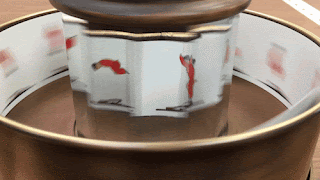Major Precursors of Motion Pictures
Muybridge with Leland Stanford's Horses
Some inventors made important contributions without creating moving photographic images. Several men were simply interested in analyzing motion.
1) In 1878, ex-governor of California Leland Stanford asked photographer Eadweard Muybridge to find a way of photographing running horses to help study their gaits.
The Horse in Motion
2)Muybridge set up a row of twelve cameras, each making an exposure in one-thousandth
of a second.
3)The photos recorded one-half-second intervals of movement.
4)Muybridge later made a lantern to project moving images of horses,
5)but these were drawings copied from his photographs onto a revolving disc.
6)Muybridge did not go on to invent motion pictures,
7)but he made a major contribution to anatomical science
8)through thousands of motion studies using his multiple-camera setup.
Eadweard Muybridge: Studies in Motion
Click here for Muybridge film
Eadweard Muybridge - Studies in Motion (Sothebys, 2017)
description: Eadweard Muybridge’s pioneering studies of motion are some of the most recognized images in the history of photography. His subjects ranged from exotic animals in locomotion to dancers – each displaying a playful and inquisitive eye. Muybridge’s determination to capture motion famously led to his proving that a horse does in fact pick all four hooves up from the ground when it gallops, a popularly debated question of the day. Real filmmaking would begin 2 years later.
Muybridge's Zoopraxiscope (Kingston Museum)
Click Here for Muybridge's Zoopraxiscope
Zoopraxiscope definition, an early type of motion-picture projector, designed by Eadweard Muybridge, in which the images were drawings or photographs .
In 1882, inspired by Muybridge’s work,
French physiologist Étienne Jules Marey
1) studied the flight of birds and other rapid animal movements
2) by means of a photographic gun.
3) Shaped like a rifle, it exposed twelve images around the edge of a circular glass plate
that made a single revolution in one second.
4)In 1888, Marey built a box-type camera that used an intermittent mechanism
to expose a series of photographs on a strip of paper film at speeds of up to
120 frames per second.
5)Marey was the first to combine flexible film stock and an intermittent mechanism in
photographing motion.
6)He was interested in analyzing movements rather than in reproducing them on a screen,
7) but his work inspired other inventors.
8)During this period, many other scientists used various devices to record and analyze motion.
Étienne-Jules Marey: Sport in the Darkroom (The Olympic Museum, 2017)
Click Here for Etienne film clip
A fascinating and isolated figure in the history of the invention of the cinema was Frenchman Émile Reynaud.
1)In 1877, he had built an optical toy, the Projecting Praxinoscope.
2)This was a spinning drum, rather like the Zoetrope,
3) but one in which viewers saw the moving images in a series of mirrors
Rather than through slots.
4)Around 1882, he devised a way of using mirrors and a lantern to project a brief series of
drawings on a screen.
5) In 1889, Reynaud exhibited a much larger version of the Praxinoscope.
6) From 1892 on, he regularly gave public performances using long, broad strips of hand-
painted frames.
7)These were the first public exhibitions of moving images,
though the effect on the screen was jerky and slow.
8)The labor involved in making the bands meant that Reynaud’s films could not easily be
reproduced.
9)Strips of photographs were more practical, and in 1895 Reynaud started using a camera to
make his Praxinoscope films.
10)By 1900, he was out of business, however, due to competition from other, simpler motion-
picture projection systems.
11)In despair, he destroyed his machines, though replicas have been constructed.
The praxinoscope is essentially a zoetrope that uses mirrors.
Projection Praxinoscope
Click Here for clip of Projection Praxinoscope
Praxinoscope Theatre
Click Here for clip of Projection Praxinoscope
Another Frenchman came close to inventing the cinema as early as 1888
1)Six years before the first commercial showings of moving photographs.
2)That year, Louis Le Prince, working in England, was able to make some brief films,
shot at about sixteen frames per second, using Kodak’s recently introduced paper
roll film.
3)To be projected, however, the frames needed to be printed on a transparent strip;
4)lacking flexible celluloid, Le Prince apparently was unable to devise a satisfactory
projector.
5) In 1890, while traveling in France, he disappeared, along with his valise of patent
applications, creating a mystery that has never been solved.
6)His camera was never exploited commercially and had virtually no influence on the
subsequent invention of the cinema.
INTRODUCTION TO A FILM CLIP
Roundhay Garden Scene is an 1888 short silent actuality film recorded by Le Prince.
1) Filmed at Oakwood Grange in Roundhay, Leeds in the north of England on 14
October 1888, it is believed to be the oldest surviving film in existence.
Click here for Roundhay Garden Scene clip
Digital archivist Denis Shiryaev upscaled in 2020 at 4K (60 fps) Upgraded with modern technology Click Here for Denis Shiryaev clip
12 frames per second so slow - the original.


No comments:
Post a Comment